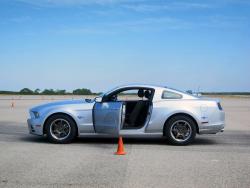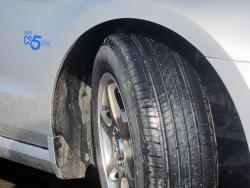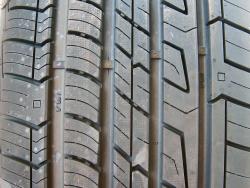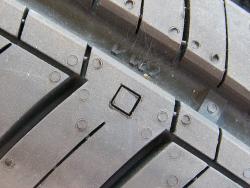    Cooper CS5 Grand Touring – 2014 Ford Mustang V6 at Cooper Tire and Vehicle Test Centre, detail of 3D Micro-Gauge siping & Wear Square. Click image to enlarge |
Review and photos by Paul Williams
San Antonio, Texas – It’s 2014 and there’s another automotive-related anniversary to celebrate (it’s the Ford Mustang’s 50th, the Mazda MX-5 Miata’s 25th, Dodge’s 100th). Ohio-based Cooper Tire has been in the tire production business since 1914, rising to the fifth largest tire company in the US and the 11th largest globally.
I mention this because, well, it’s a major achievement for any company to stay in business for a century, but also because Cooper Tire, successful as it is, may not reside in your personal list of major tire companies.
It’s what is known as a Tier 2 tire manufacturer, largely based on the market segment it targets (passenger car and light vehicle replacement tires) and the price of its merchandise (what you might generally describe as, “in the middle”).
But there’s nothing wrong with value, and the company’s been on a tear lately, introducing several new tires over the past couple of years including the ultra-high-performance Zeon RS3-A.
We were in San Antonio – actually an hour away at the Cooper Tire and Vehicle Test Centre near Pearsall – experiencing the latest tire from Cooper, the all-season CS5 Touring. It’s a premium tire, available in Ultra and Grand versions, targeted directly at Cooper’s familiar market: passenger cars, SUVs and CUVs, but also suitable for higher performance sport sedans and coupes, along with luxury and higher performance SUVs. “Performance for everyday driving,” is one of the Cooper taglines.
The difference between the CS5 Ultra Touring and the CS5 Grand Touring is the tire speed rating and the warranty. The CS5 Ultra Touring can be purchased as an H, V or W-rated tire, meaning its top speed is 210, 240 and 270 km/h respectively (not that you’re likely to go that fast, but that’s how tires are rated). The warranty ranges from 80,000-96,000 kilometres, depending on which one you require.
The CS5 Grand Touring is a T-rated tire, meaning its top speed is a more modest 190 km/h. Its warranty therefore extends to 130,000 km.
On the road, the CS5 Ultra Touring exhibits slightly sharper handling and firmer ride characteristics than the CS5 Grand Touring, while the latter tire offers a slightly smoother and more compliant ride. The difference has to do with the way the tire is constructed: the higher speed rated tires requiring more rigid materials and construction methodologies. Expect the CS5 Grand Touring to cost less than the CS5 Ultra Touring.
The new CS5 line of tires replaces the CS4, which has been the most successful tire in Cooper Tire’s history. It has big boots to fill, in other words, but Cooper Tire executive Matt Snider explains that the CS5 equals or improves all of the CS4’s strengths and significantly improves dry and especially wet handling.
The tire uses several proprietary technologies including a new “coupled silica compound” (the mix or recipe of the rubber) that boosts the amount of silica and uses special polymers that chemically bond with the silica to optimize ride, handling and wear characteristics. The compound is designed to wear evenly, preventing the tire from getting louder after an extended period on the road. The compound also contributes to better fuel economy by lowering the tire’s rolling resistance (perhaps a 0.5-percent improvement, but every little bit helps).
Cooper’s “3D Micro-Gauge” siping extends the depth of the tire sipes, enabling the tire to perform as designed for longer, better flex in dry conditions and more efficiently evacuate water when driving on wet surfaces. These deep sipes feature the use of Stabiledge technology where small protrusions inside the sipes prevent them from closing due to forces exerted on the tire when driving.
Another interesting feature is the new Wear Square, several of which are embedded in the tire to display how the tire is wearing. Basically, you can see small squares located within the tread section which over time wear in such a way that you can determine how much life is left in the tire and, depending on whether you rotate the tires, the accuracy of your vehicle’s wheel alignment. Eventually, the “wear square” disappears, replaced with an exclamation mark. Time to change your tires!









